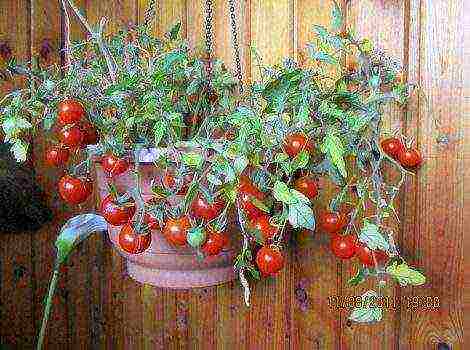Content
- 1 Features of indoor tomatoes
- 2 The best varieties of indoor tomatoes
- 3 Ampel varieties
- 4 Agricultural technology for growing indoor tomatoes
- 5 Tomatoes on the windowsill: is it real?
- 6 The best indoor varieties for a mini-garden at home
- 7 Proper seed preparation for planting at home
- 8 Transplanting tomato seedlings and further care
- 9 Home window tomatoes - growing and caring
- 10 Features of planting indoor tomatoes
- 11 Homemade tomatoes - growing on the balcony
- 12 The main recommendations for the successful cultivation of tomatoes on a windowsill or balcony
Thanks to the efforts of breeders, tomatoes can be grown on the windowsill, and at any time of the year. There are many varieties that can produce good yields indoors. Growing them is no more difficult than ordinary tomatoes in the garden, moreover, they are not afraid of either drought or the Colorado potato beetle. To enjoy fresh tomatoes in the winter cold, you need to study all the nuances of such cultivation, but the most important thing is to choose the right variety.
Tomatoes on the windowsill in winter
Features of indoor tomatoes
Indoor conditions differ significantly from those in the garden, so not every variety of tomatoes will be able to grow and bear fruit normally indoors. Varieties for growing on a windowsill have the following characteristics:
- short stature. Due to the limited space, only undersized and dwarf tomatoes are able to form a crop. Tall tomatoes require not only a lot of space, but also a large amount of nutrients, and there is too little soil in the flower pot for this;
- stamina. Not everyone knows how to form a bush correctly, but this is an important condition for the yield of a tomato. Standard varieties have a strong central stem and a dense crown; it does not need to be pinned or tied up;
- resistance to lack of lighting and disease. Indoor plants receive less light, especially in winter, and therefore really need additional lighting. But there are varieties of tomatoes that bear fruit normally in a short day, and they only need backlighting on cloudy days. Their genetic feature is short internodes, due to which the stems do not stretch. Of the diseases, tomatoes are most threatened by black leg (during the period of growing seedlings) and leaf mold. The most resistant to them are hybrids, which make up 90% of the total number of potted tomatoes.
Cherry tomatoes on the windowsill
In addition to these features, indoor tomatoes are distinguished by the highest taste qualities, and are rightfully considered the champions among tomatoes in terms of the content of vitamins and sugars in the pulp. But not all of them can boast of productivity, because some varieties are more decorative, and form very small, cherry-sized fruits. Of course, they are also edible, but there are too few of them, and therefore they are most often used to decorate dishes.
Indoor tomatoes
If you need tomatoes for daily consumption, choose large-fruit varieties that are high-yielding. As a rule, the mass of indoor tomatoes varies between 15-130 g, depending on the variety. The best of them form low bushes completely covered with fruits. On average, one bush can produce up to 2 kg of tasty, marketable tomatoes per season.
Potted tomatoes have one more feature - they are perennials.If, after collecting the last fruits, the bush is not thrown away, then after a while new leaves will appear on the stem. Usually such tomatoes grow and bear fruit within 5 years, although the most abundant harvests are given in the first 2 years.
Growing tomatoes on a windowsill
The best varieties of indoor tomatoes
The assortment of indoor tomatoes is smaller than usual, but also impressive. Varieties differ in shape, size and color of fruits, height and shape of the bush, ripening time and other parameters. Every year, new varieties and hybrids from leading breeding companies are added to their list. Below are the most popular windowsill tomatoes.
|
Balcony miracle |
This early ripe variety forms standard bushes up to half a meter high. Its fruits are red, round, with a high sugar content. Unlike most potted tomatoes, this variety grows up to 70-100 g. With good care, the yield per plant is about 2 kg. The balcony miracle adapts well to a lack of light and can bear fruit perfectly in winter |
|
Room surprise |
Early ripening, standard. The height of the bushes does not exceed half a meter, and the weight of bright red elongated fruits, collected in bunches, is equal to 25-30 g. The pulp of these tomatoes is very tasty and aromatic, they are great for salads. In winter, the plant needs lighting, otherwise the harvest will be rather weak. |
|
Bonsai |
A neat lush bush up to 30 cm high.Tomatoes of this variety have a rounded shape and rich red color, the weight of the fruit is 25 g. With good care, each plant gives 1 kg of tasty commercial tomatoes per season |
|
Micron NK |
Today it is considered the smallest type of tomato, the height of its bushes is only 12-15 cm. Round, small fruits (10-12 g) are yellow and red. You should not expect a large harvest from it, but in terms of decorativeness, the variety is ahead of most potted tomatoes. Ideal for winter growing, as it does not depend on the length of daylight hours |
|
Pinocchio |
One of the best potted varieties. Plants are not tall, maximum 30 cm, densely leafy, compact. Fruit weight - about 20 g, red color. One bush yields from 1 to 1.5 kg of tomatoes, which are suitable not only for salads, but also for canning. In the summer, it can be grown in the beds, and in the fall, the bushes are transplanted into pots and brought into the house. |
|
Pygmy |
Its fruits ripen 85-90 days after germination. Standard variety, universal use, bears fruit well in a short day. His tomatoes are small, weighing 25 g, red, fragrant. The bush itself looks very decorative during the ripening period. |
|
Florida Petite |
A popular variety appreciated for its high yield. The bushes are compact, do not exceed 30 cm in height, do not need pinching. Its fruits are small (20-40 g), red in color, with very sweet pulp. The ovaries are collected in long clusters, and during the ripening period of the leaves is almost invisible under the fruits. The variety is resistant to low light and bears fruit well in winter. |
|
Bunch of honey |
Yellow-fruited and early ripening variety. Can be grown both on the windowsill and in the open field. The height of the standard bushes does not exceed 40 cm, the crown is dense, does not need to be formed. Tomatoes weigh about 40 g, the yield is very high. The peel of the fruit is thin, orange in color, the pulp is sweet and juicy |
|
Window yellow |
A new, still rare variety. The plant is a standard plant, 25 cm tall, during the fruiting period the entire bush is covered with clusters of yellow small round tomatoes. Fruit weight rarely exceeds 30 g, the pulp is very sweet. The variety is neutral to low light, therefore it bears fruit well in winter. |
|
Teeny Tim |
Early maturing popular Dutch variety. Bears fruit regardless of the season and the degree of lighting. The height of the bushes is about 30 cm, in the open field it can grow up to 50 cm.The weight of the tomatoes is 12-14 g, the color is red, the pulp is moderately sweet |
Ampel varieties
In addition to the standard varieties, ampel tomatoes are also in demand among fans of indoor tomato cultivation. They can be planted in hanging pots or in tall pots, from which the shoots will hang beautifully on the windowsill. Caring for them is a little more difficult than for ordinary varieties, and the yield is lower, but all this is offset by the excellent taste of tomatoes and the high decorative effect of the bush. The choice of ampel varieties is still small, and seeds can be purchased only from a few domestic agricultural firms.
|
Garden Pearl |
A spreading bush with shoots up to 50 cm. The plant's stems are thin, but strong, and do not break under the weight of numerous fruits. You do not need to walk the bush. Round tomatoes weighing 15-20 g, when ripe, acquire a raspberry color and become translucent. On one plant there can be up to three hundred fruits of a presentation. The variety is very decorative, feels great indoors and outdoors |
|
F1 Citizen |
Spectacular early maturing hybrid. It can grow vertically (but then it is necessary to tie up the stems) and as an ampelous plant. His tomatoes are round, red, with a characteristic tomato flavor, weighing about 30 g. The hybrid is specially bred for indoor cultivation, therefore it develops well and bears fruit regardless of the season |
|
Cherry Fingers F1 |
New yielding hybrid for ampel cultivation. Low-leafed shoots, up to half a meter long, strong. Small red fruits have an elongated shape, are attached to long clusters of 8-10 pieces. Tomatoes are suitable for harvesting for the winter; they do not crack during heat treatment. In good conditions, the yield of one bush is 1.8-2 kg |
|
Toggle switch |
One of the new ampelous varieties. Very early, has a cascading bush shape, the mass of tomatoes is 25-30 g. The taste of the fruits is excellent, the average yield is about 2 kg. With a lack of lighting, the number of fruits is slightly less |
|
Mascot |
Already a fairly well-known ampelous variety of domestic selection. Refers to medium early, the bush is quite compact, shoots up to 55 cm long. Egg-shaped fruits of red color, average weight about 40 g. When grown in open ground, the mass of fruits is almost twice as large. The variety is distinguished by extended fruiting, and very abundant. Tomatoes are juicy, tasty, can be preserved |
|
Red Abundance F1 |
A very attractive yielding hybrid. Shoots grow up to 60 cm, the plant does not need pinching. The brushes are densely covered with small (20g) sweet red fruits, which are suitable for canning. The bush grows quickly, so it needs a lot of space. In winter, the plant must be highlighted, otherwise the yield will decrease |
Agricultural technology for growing indoor tomatoes
As with regular varieties, indoor tomatoes are best grown through seedlings. And at this stage there are no differences, except that the timing of sowing seeds is different. On average, potted tomatoes begin to bear fruit in 90-100 days after germination, and if you want to get the first tomatoes by a certain date, take this factor into account. For example, to harvest the first crop in January, plant the seedlings at the end of September.
Two ways to test seeds for germination
Before sowing, the seeds are disinfected by soaking for 15-30 minutes in a weak solution of potassium permanganate, and then left in a damp cloth for a couple of days for pecking.
Tomato seed preparation
Sow in a common container with ordinary soil or purchased substrate to a depth of no more than 1 cm. The distance between the seeds should be within 2-3 cm so that the seedlings are not thickened.
Capacity for growing tomatoes
Tomatoes in a box
Seedlings are transplanted into separate containers as soon as 2-3 true leaves are formed in the seedlings. The sizes of pots are selected depending on the variety of tomatoes: for dwarf tomatoes, a volume of 1.5-2 liters is enough, for ordinary room ones 3-4 liters, for ampelous ones - at least 5 liters.All pots must have drainage holes. It is very important to properly prepare the soil, because the development and fruiting of the bush depends on its composition.
Soil preparation
The best option is the following composition:
- 5 parts of garden soil;
- 2 pieces of sand;
- 5 parts of rotted compost;
- 1 part peat.
On a bucket of such a mixture, it is necessary to add a matchbox of urea and potassium sulfate, a handful of sifted wood ash. All this is thoroughly mixed. Now you can start planting seedlings.
Step 1... A drainage layer of fine gravel, pieces of bark, expanded clay or other material is poured onto the bottom of the pots. Fill the containers to the top with soil and make a small depression in the center.
Filling the pot with drainage and soil
Step 2. The pre-watered seedlings are carefully removed one at a time and planted in pots, deepening to the cotyledonous leaves. Water gently.
Planting tomato seedlings in a pot
The soil must be saturated with moisture for the water to get to the roots.
Step 3. They put the pots on the windowsill (preferably on the south side) and regularly turn them on the other side to the light every 2 days. In the mornings and evenings, as well as in cloudy weather, plants should be supplemented with a phytolamp.
Supplementary lighting of tomatoes with phytolamp
After a week, the plants are fed with half the nitrogen fertilizer required for growth. During the flowering period, in order to increase the percentage of pollination, the stems of the plant are very lightly shaken and carried over the flowers with a feather or a soft brush. After the formation of ovaries, potash fertilization is required every two weeks.
In varieties that need to form a bush, remove stepchildren, pinch the top of the main stem, cut off excess inflorescences to increase the size of the fruit. Tall bushes are tied to supports, which are stuck into the ground along the edge of the pot.
Tomato care
If signs of fungal infection appear, all plants are sprayed with phytosporin or another anti-fungal agent. To prolong fruiting, regularly pick ripe fruits, remove dried leaves, do not forget about dressing and watering. The soil in pots should be periodically loosened, being careful not to catch the roots. With this care, your tomatoes will delight you with an abundant harvest of sweet, tasty fruits all winter.
Video - Tomatoes on the windowsill in winter: the best varieties
Video - Tomatoes on the windowsill in winter: the best varieties and order of growing tomatoes at home
Tomatoes all year round are no longer a wonder. But if not from a supermarket package, but from a windowsill in your own apartment, this is exclusive. Juicy, ripe, sweet and, most importantly, environmentally friendly fruits on your table will delight the whole family. At the same time - no expenses, neither money, nor time. This review provides a description and characteristics of the best varieties of potted tomatoes.
Tomatoes on the windowsill: is it real?
Thanks to the efforts of breeders, many different hybrid varieties of tomatoes have appeared, unpretentious, but very productive, which easy to grow on a windowsill at home in an ordinary flower pot... By maintaining a suitable microclimate for tomato growth, you can pamper yourself with the unique taste of homemade tomatoes in winter.
 Growing a tomato on a windowsill
Growing a tomato on a windowsill
As the ripening time of various early ripening varieties varies from 90 to 110 days, it is easy to calculate the date of planting seeds so that fragrant fresh tomatoes ripen to the New Year's table. The main thing is to choose the right variety that meets all your wishes. You will be able to harvest a large crop from a limited area at any time of the year.
The best indoor varieties for a mini-garden at home
For a window bed of tomatoes, standard and ampel varieties are suitable. They develop in height no more than 35-45 cm, do not branch, which means that they do not need to be tied up.Many hybrids are adaptable to short daylight hours and lack of sunlight, good resistance to the most common diseases (black leg, leaf mold).
From neat small bushes, you will receive 1-2 kg of fruit per season.... If planted in batches in several bushes with an interval of 20-30 days, you can provide yourself with vitamins for the whole winter. In addition, indoor tomatoes have excellent taste and a higher content of sugar and vitamins in the pulp (compared to ordinary ones).
The best standard hybrids for growing on a window at home are:
Balcony miracle
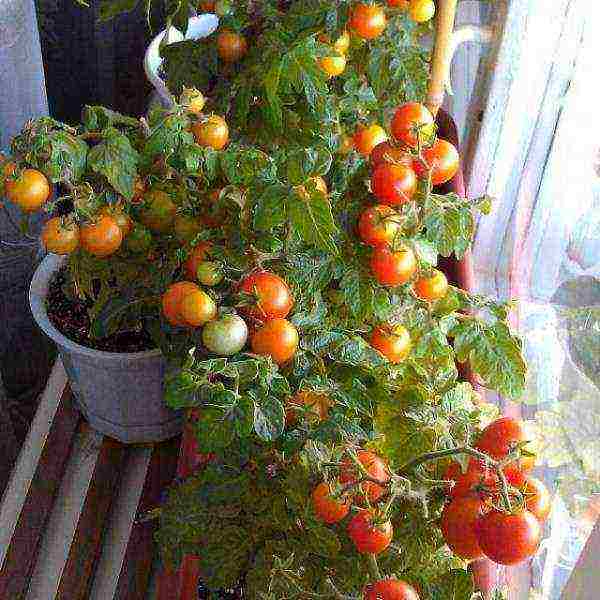 Tomato Balcony Miracle
Tomato Balcony Miracle
Forms standard bushes about 0.5 m high, tolerates a lack of light well, fruits are round, red, weighing 70-100 g, with a high sugar content. Tomato Balcony miracle begins to bear fruit within 80 days after germination.
Micron NK
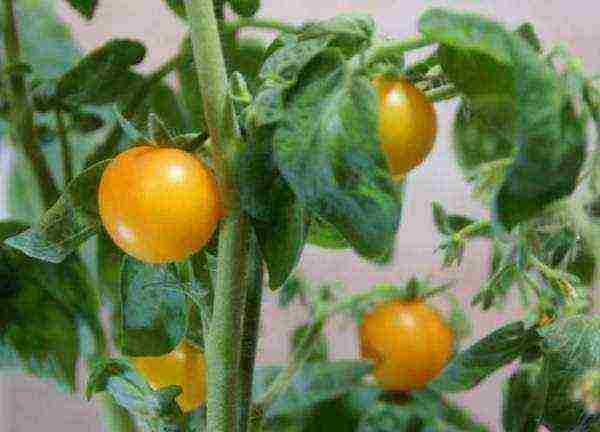 Tomato Micron NK
Tomato Micron NK
The smallest of the known varieties, the height of the bush barely reaches 15 cm, sweet fruits of red or bright yellow color, weighing 10-12 g, ripening period 100-110 days. This variety is more decorative and does not depend at all on the length of daylight hours.
Pinocchio
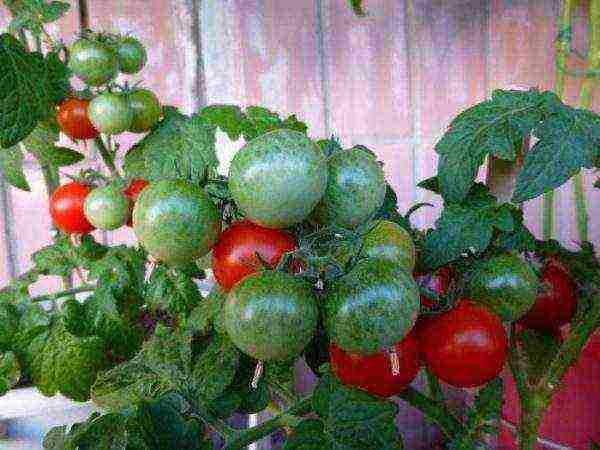 Tomato Pinocchio
Tomato Pinocchio
Compact bushes, one of the best indoor tomatoes, sweet, round fruits, weight - up to 20 g. You can grow it in the garden in the summer, and in the fall, transplant it into pots, bring it home. And if you sow the seeds after September 20, you will harvest the first harvest by the New Year. Pinocchio is mid-season, ripens in 105-115 days.
Bonsai
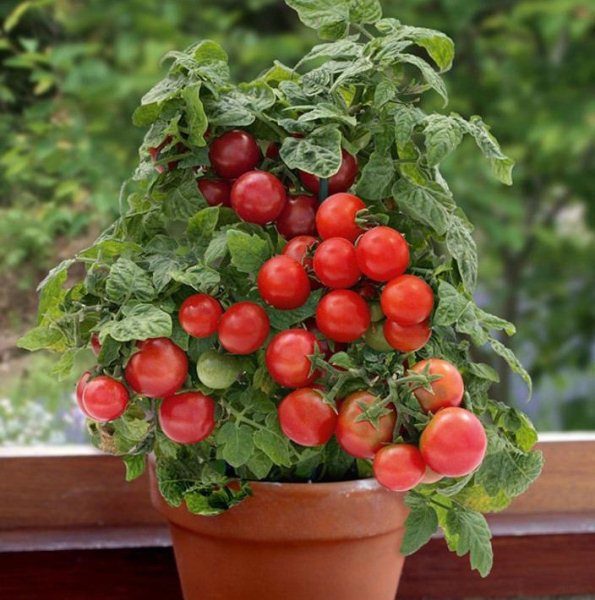 Tomato Bonsai
Tomato Bonsai
Early ripening variety (matures in 85 days), unpretentious to light, the yield is not the highest - 0.5 kg, but the fruits are very tasty and sweet;
Bunch of honey
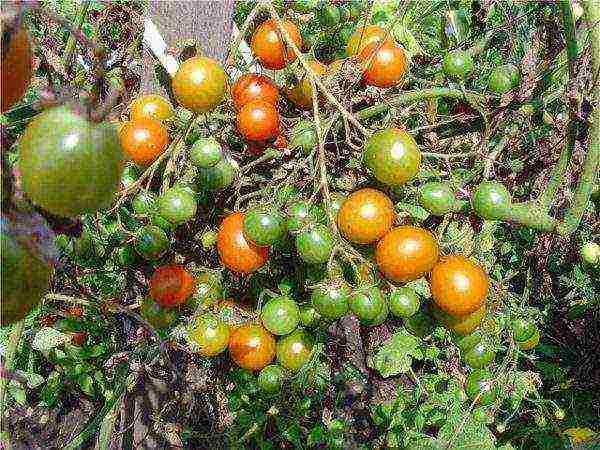 Tomato Honey Bunch
Tomato Honey Bunch
Early ripening standard bush with a dense crown, height - 40 cm, fruits are sweet, juicy, yellow. Differs in high productivity.
There are a lot of indoor and balcony varieties, and they all enjoy well-deserved popularity: Cherripals F1, Balconies Elo, Pearl yellow, Bonsai micro, F1 Balcony red, Indoor surprise, etc. A unique feature is that they can grow for more than one season. Dried bushes can be left in pots, watered occasionally, and after a while green leaves will begin to appear again. Tomatoes can grow like this for up to 5 years, but the yield will decrease. The bushes bear fruit most abundantly in the first 2-3 years.
Proper seed preparation for planting at home
The principle of growing a tomato at home is no different from growing in a garden: first we get seedlings from the seeds, then we dive them into the pots to a permanent place. In advance, you should worry about preparing for planting seeds and soil.
It is better to buy seeds in specialized stores to be sure of the quality and compliance with the variety indicated on the package.
But nevertheless, before planting, it is better to check again and sort out full-fledged grains from empty ones. To do this, dip them in salted water for 10 minutes (1 teaspoon per 200 g of water). Semi-dried or empty seeds will float, and healthy, full-fledged seeds will sink to the bottom. They need to be soaked for 20-30 minutes in a manganese solution, to protect future plants from late blight.
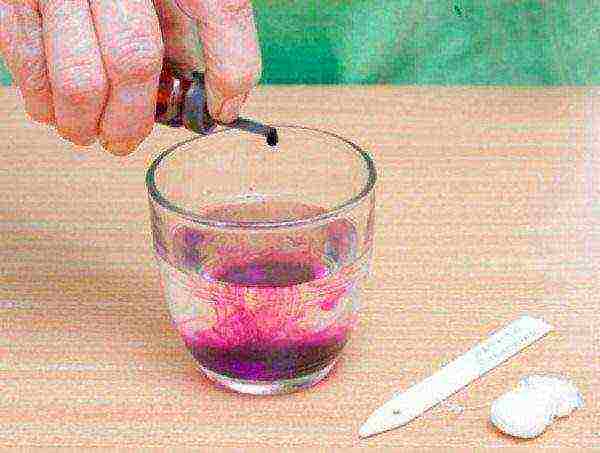 Manganese solution preparation
Manganese solution preparation
To accelerate the germination of seeds for a couple of days, you can put them in a damp cloth for "pecking". Tomato seeds prepared in this way are sown in a container for seedlings in moistened soil to a depth of 1 cm and at a distance of 3 cm from each other. After that, the soil is lightly tamped, covered with plastic wrap and removed to a warm place until shoots appear. The film must be chopped in several places so that excess moisture does not accumulate under it, as this can cause seedling diseases. It is desirable to maintain the daytime temperature + 22-25 degrees, the nighttime - + 15-17.
After about a week, the first leaves (false) appear, the temperature at this time is lowered to 20 degrees and the room is occasionally ventilated. It is also necessary to monitor the humidity - do not overdry, but also do not overmoisten, so that the seedlings do not get sick with a "black leg".
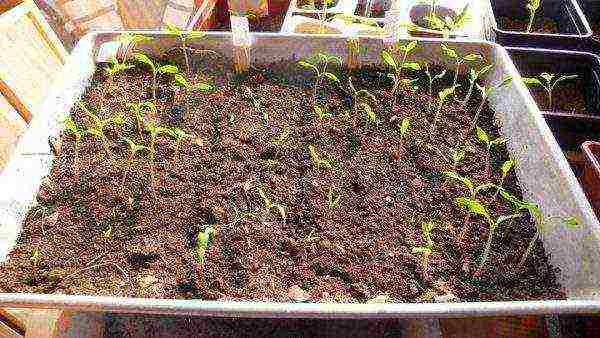 After 7-10 days, you can observe the first shoots of the tomato
After 7-10 days, you can observe the first shoots of the tomato
You can prepare the soil yourself or buy a ready-made substrate. For healthy plant growth and a good harvest, the following mixture is most suitable:
- the soil itself must be from 50% humus, 45% black soil, 5% sand;
- to enrich 1 glass of wood ash is added to one bucket of soil, 1 matchbox of superphosphate, potassium sulfate, urea.
Fill containers with this mixture - plastic cups with drainage holes or wooden boxes with pallets 10-12 cm high.
Transplanting tomato seedlings and further care
After 2-3 true leaves appear on the seedlings, it is necessary to pick the seedlings, i.e. you need to choose the strongest and most developed sprouts and plant them in pots or other containers specially prepared for this. The container size should be 8-10 liters, for the smallest decorative varieties of tomatoes, you can take a container of 4-5 liters in size. In the process of caring for plants, you need to follow the elementary rules and technologies of agricultural technology:
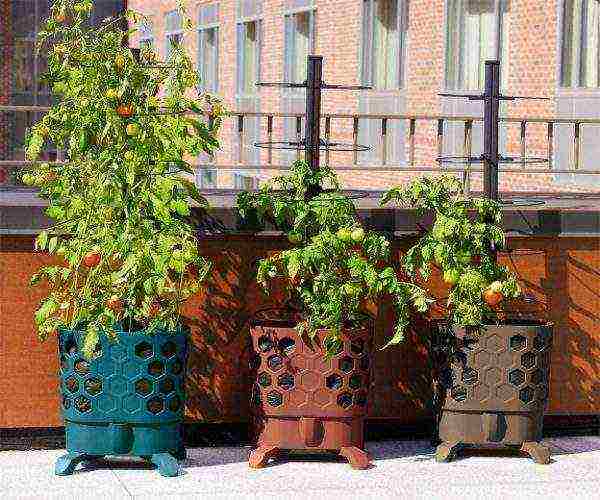 For growing indoor tomatoes in winter, choose containers with a volume of 2 liters (for dwarf varieties), 4 liters (for medium-sized varieties) or 5 liters (for ampelous plants)
For growing indoor tomatoes in winter, choose containers with a volume of 2 liters (for dwarf varieties), 4 liters (for medium-sized varieties) or 5 liters (for ampelous plants)
- Lighting. Tomato pots are placed on the windowsills on the south side. Once every two days, they are turned 180 degrees so that the plant is even and does not lean towards the sunny side. In cloudy weather, as well as in the mornings and evenings, it is necessary to provide plants with additional lighting - phytolamp or even ordinary electric lamps (except for those varieties whose growth does not depend on the length of daylight hours).
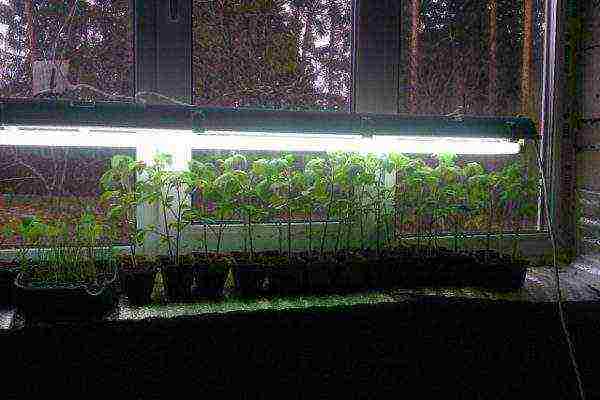 With a lack of sunlight for indoor tomatoes, additional lighting is equipped
With a lack of sunlight for indoor tomatoes, additional lighting is equipped
- Watering. Indoor tomatoes are very sensitive to watering. Regular moistening of the soil promotes good growth, ovary formation and fruit ripening. A lack of moisture will lead to the falling of the fruit, but an excess of it leads to the spread of various diseases - rot, late blight, fungal infections. You need to water 2 times a week, in moderation and not watering the stems. With the beginning of flowering, watering must be stopped and resumed with the appearance of ovaries.
- Top dressing of tomatoes. Three weeks after the dive of the seedlings and then every 10-15 days, we fertilize the plants with special mineral and organic fertilizers, which we apply to the moist soil on the second day after watering.
- Tying whips. Low standard bushes with a stable trunk usually do not need support. The branches of medium-sized tomatoes are tied to pegs, which are stuck into the ground, trying not to damage the root system.
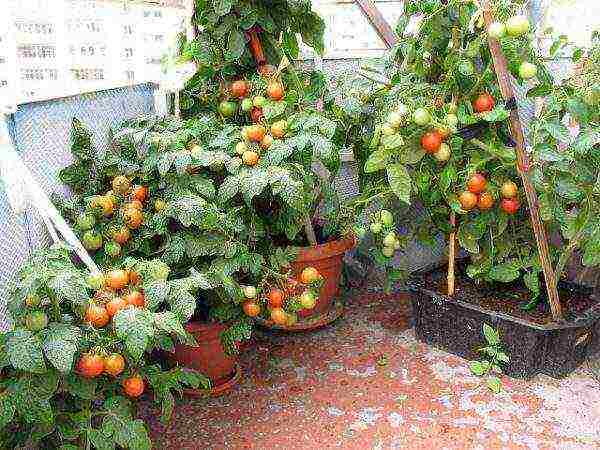 As they grow, the stalks of the tomatoes are tied to pegs.
As they grow, the stalks of the tomatoes are tied to pegs.
- Stealing. It is imperative to carry out pinching, i.e. removal of “stepchildren” shoots in the leaf axils throughout the entire growth of plants for its correct formation. Stepsons thicken the plant, take away nutrients, and reduce the yield of tomatoes.
After the formation of the main ovaries, it is also necessary to rip off the top.
- Pollination. Indoor varieties yield a fairly good harvest without pollination, but if desired, pollination can be carried out with a brush, carefully brushing it over the flowers.
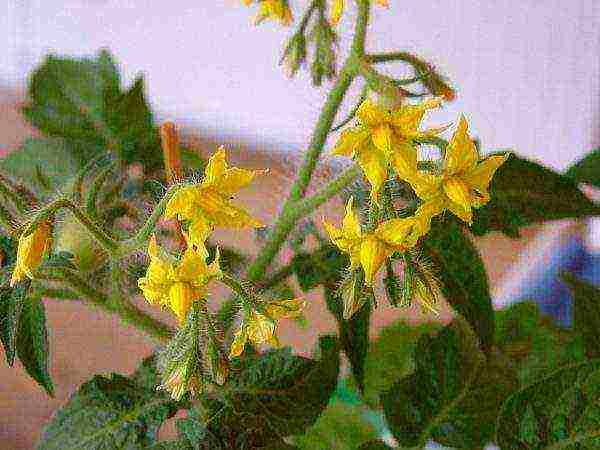 Airing will help to improve the ability of a tomato to self-pollinate.
Airing will help to improve the ability of a tomato to self-pollinate.
Growing hybrid varieties of tomatoes on a windowsill in winter - this is not only a benefit, but also a great pleasure, a very interesting activity. With a little attention and free time, you will get a harvest of exclusive varieties of bright, sweet and very healthy tomatoes from your windowsill. It will be easy to care for such a plant even for novice gardeners.
Foreword
If you want to get a crop right at home, then this is quite possible when it comes to tomatoes. Many people have already mastered growing tomatoes at home - now it's your turn.
Home window tomatoes - growing and caring
As practice shows, such a mini-vegetable garden can be easily made at home, on your windowsill. Experienced gardeners manage to grow not only tasty and fragrant tomatoes on an ordinary closed balcony, but also various herbs, peppers, lettuce, lemons, tangerines, pineapples and more. If you also want to join those who easily grow various vegetables and fruits in winter, then carefully read all the tips collected for you.
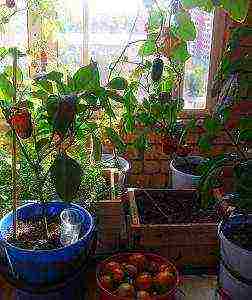
Apartment windowsills are a good enough place to grow tomatoes. As practice shows, varieties with small tomatoes take root well in ordinary apartments, regardless of the height of the house and other indicators. Dwarf varieties have proven themselves best when grown at home like this, so it makes sense to take them for such purposes. Specialty stores sell packets of seeds, which indicate that they are recommended for "pot" growing - these are the tomatoes for the windowsills.
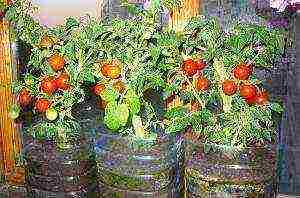
You can choose tomatoes by taste, by color (pink or bright red), and by shape - round, oblong or very small. Some varieties (Cherry, Talisman) can be grown in hanging pots, in which hanging flowers grow. If you decide to start growing tomatoes in winter, then you will need to sow seeds to get high-quality seedlings in July or August.
Features of planting indoor tomatoes
So, in the summer, starting from the second month, you can start sowing. You will need light and preferably fertile soil for growing seedlings on a balcony or windowsill - there is everything you need in specialized stores. Tomato seeds only need to be covered with earth, and the soil should be moistened with a spray bottle. Constantly maintain humidity and keep the trays with future seedlings warm - after a week or two, the first sprouts will appear.
They need a lot of light, a moderate amount of moisture and very little nitrogen fertilizer to grow.
The next stage is to dive the already grown seedlings. Sprouts with two or three true leaves are considered grown up. For picking, you need to prepare separate containers, for example, flower pots. In principle, indoor tomatoes can be grown using the seedless method. But it is believed that the first method gives stronger seedlings with a powerful root system. Given that this culture loves a lot of light, it is advisable to prepare a fluorescent lamp for seedlings, especially if you sowed seeds in winter. Indeed, even in the presence of direct winter sunlight, it will not be enough for seedlings on the window.
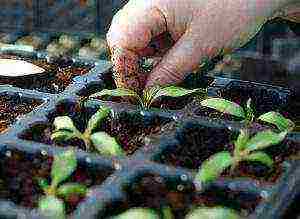
Watering must be regular. As soon as you see that the top layer of the soil has begun to dry out, then immediately you need to add a little warm settled water. If you decide to grow tomatoes in pots, then you need to water them even more often. At the same time, the culture does not tolerate excessive air humidity, so it is not advisable to leave tomato seedlings in a damp room.
Do not forget about top dressing - fertilizers are necessary for the soil and after the dive. The best care option is to feed the tomatoes every 14-15 days. To do this, you need complex mineral or organic fertilizers.
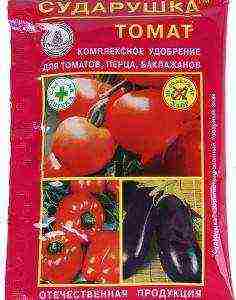
Growing tomatoes on an apartment window sill or balcony of a house in winter has its own characteristics - for example, in ampel varieties suspended in pots, stepchildren must be removed. These small outgrowths are removed in order for the plant to bear fruit better. If we are talking about dwarf seedlings, then in this case there is no need to prune the stepsons.
Homemade tomatoes - growing on the balcony
Seeds of large varieties, which are usually planted in greenhouses or ordinary beds, it is better not to try to grow in an apartment. After all, if they are sown in pots, the plants will not have enough room for a large and powerful root system.
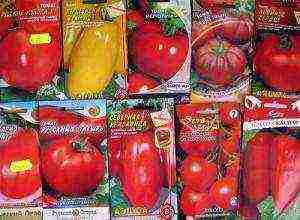
With a sufficiently large amount of soil on the balcony, some large and high varieties of houses can still be planted. The same Tomato Bovine Heart or Carlson varieties, White filling. But the best option for growing tomatoes on a windowsill or a small balcony, as we have already noted, is varieties up to 25–35 centimeters high.
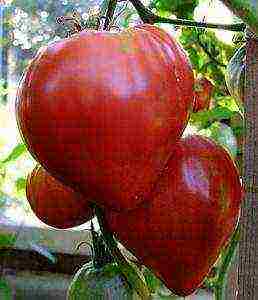
So we advise you to take such wonderful and juicy varieties as Japanese Indoor, Balcony Miracle, Dubok, and Rubin. All of them can give you a wonderful harvest on your balcony. This has been proven by many amateur gardeners with their experiments at home. So growing ripe tomatoes on a windowsill in winter is a reality! In winter, the taste of fresh homemade tomatoes will delight you.
Rate the article:
(1 vote, average: 5 out of 5)
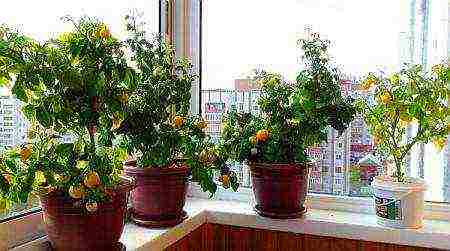
Without having your own land, you can feast on freshly picked fragrant tomatoes, growing them on a balcony or windowsill... Most often, people want to grow vegetables on the windowsill in winter, when the summer season is far away, but they want to tinker with the land. But even in the warm season, this is an excellent solution for residents, for example, apartment buildings. Of course, this is not a way to fully feed a family, but an opportunity not only to save a little, but also to get moral satisfaction. Everyone is pleased not only to see the result of their work, but also to taste it, because vegetables grown with their own hands are always the most fragrant and tasty, and most importantly, healthy and not treated with pesticides.
Growing tomatoes and caring for them in an apartment is not very different from growing them in the open field and caring for indoor plants. But there are also some peculiarities. Breeders have bred a large number of tomato varieties specifically for growing in the room. If you want to grow tomatoes on a windowsill, then it is better to choose undersized varieties, for example, Florida Petit (Little Florida) and Dubok. Outdoors, plants grow 25 to 35 cm tall. In the room, they stretch up to 40 - 50 cm, but at the same time, the trunk of the plant is strong enough and there is no need to tie up the plants.
They are distinguished by the compact size of the bush and high decorative effect. The fruits on them are small in size, but very tasty. And due to the fact that there are many of them on each bush, the harvest is quite decent. Also, such undersized varieties as "Pinocchio", "Balconnoe miracle", "Pugovka", "Bonsai", "Mikron NK", etc. have proven themselves well.
If you have a large, well-lit balcony or loggia, then you can try to plant large-fruited and tall varieties: "Bull's Heart", "Cream", "De Barao", "White filling", "Carlson". But in this case, it must be borne in mind that for one such bush you need at least 10-15 liters of soil.
Planting tomatoes
For seedlings to appear faster, the seeds must be pre-soaked. To do this, you need to place them in a pale pink solution of potassium permanganate for 10-15 minutes. Then throw out the seeds that have not sunk to the bottom, and remove the rest, wrap them in a wet cloth and wait for them to hatch. If the manufacturer has applied a special protective and nutritious film to the planting material, soaking is not necessary.

Suitable for planting tomatoes "Universal" soil, which you can buy or make yourself by mixing black soil, sand and peat in equal proportions. To enrich the earth with minerals, it is better to add sifted charcoal. Before planting, the soil should be doused with boiling water, and then allowed to cool. Thus, it is disinfected, warmed up and well moisturized.
For sowing seeds 200 ml plastic cups can be used. It is advisable to choose transparent cups so that you can control watering. Do not make holes for water at the bottom, since with a small volume, the soil will not have time to absorb a sufficient amount of water. The glass must be filled with earth, leaving a free space somewhere on the finger at the top. Make a hole 2 cm deep, plant 2 seeds, fill the depression with soil. After that, the glasses should be covered with plastic wrap to prevent moisture evaporation and placed in a dark place with a temperature of 24-26 ° C. On the third or fourth day, as soon as the first shoots appear, we transfer the crops to a cool windowsill with artificial lighting so that the seedlings do not stretch too much, and do not water until the top layer of the soil dries up to avoid the development of fungal diseases.
!!! A great danger to tomatoes is represented by fungal diseases, the appearance and spread of which is facilitated by dampness. The development of the disease is impeded by sunlight and free access to fresh air. Spraying with Bordeaux mixture is a good remedy for combating plant diseases. For its preparation, it is necessary to dissolve 10 g of copper sulfate in a glass container in 0.9 l of water, and dilute 20 g of slaked lime in 0.1 l of water. Pour the milk of lime in a thin stream into the vitriol solution, stirring continuously. The finished mixture is stored for no more than 24 hours.
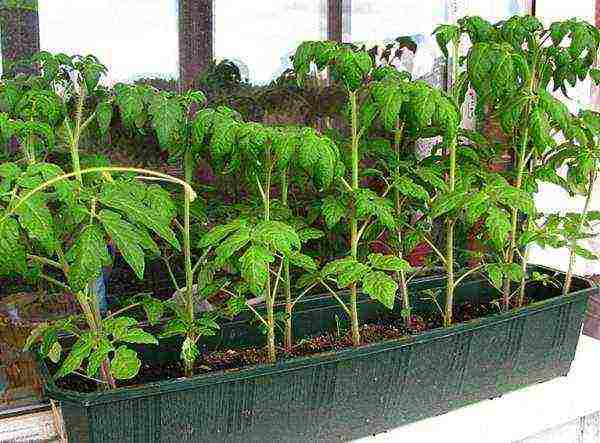
When two or three "real" leaves appear, transplant the tomatoes into large pots. For dwarf tomatoes, a container with a volume of 4-5 liters will be enough, but the more space, the better. Put expanded clay or pieces of polystyrene at the bottom of the pot, pour a layer of sand 2-3 cm and a little soil. Water the seedlings lightly, and then carefully remove from the glass along with a lump of earth. Place the seedling in a pot and fill the free space with soil. If more than one sprout has grown, then it is better to leave one of the healthiest, and pinch off the rest with your hands at the root. Pour 2-3 cm of earth on top and water. Thus, there should be 5-7 cm free in the pot to the top edge. This will make it possible to pour soil into the pot as the plant grows, thereby replacing hilling.
Watering
Water the tomatoes it follows differently depending on the return and the time of year. In the first month of the life of tomatoes, the soil must be moistened often, every day or every other day, but in moderation. Further, the plants can be watered more abundantly and less frequently. When the tomatoes begin to bloom and the ovary appears, do not allow the earth to dry out. The tomato does not like high humidity. It is advisable to water the plants a couple of times a week, abundantly wetting the soil. For irrigation, it is better to use water with a temperature of 20-25 ° C. It is not necessary to erode the soil under the bush - just enough to keep it moist. It is best to water the plants in the evening. If it so happens that you need to water during the day, then it is better to do this through the pallet. Tomatoes should not be watered on a sunny day. Water should not fall on the leaves or stem of the plant, since water droplets, like small lenses, focus the sun's rays and plants can get burned. On particularly hot summer days or if the air at home is very dry, spraying can help. During this period, adhere to the rule "it is better to overfill than underfill." But the winter period and cloudy days, on the contrary, "it is better to underfill than to pour."
Lighting
Tomatoes are very demanding on lighting. In order not to use artificial lighting, it is better to plant seeds in late March - early April, and place the plants in the south or southeast. For even illumination, once every two days, you can turn the tomatoes with the other side to the window.
On cloudy short winter days, it is simply impossible to grow lush bushes in an apartment without additional lighting.It is no secret that light is the main component of the process of photosynthesis, which is important for a plant, without which normal growth and development of a plant does not occur.
Additional lighting can be organized using fluorescent lamps of white and daylight. Such lamps provide illumination similar to sunlight without generating heat. Therefore, they can be located close enough to the plants. Also, in specialized stores you can buy phytolamps, adapted specifically for indoor growing of vegetables.
Top dressing tomato
For better fruiting, it is recommended to carry out plant feeding with organic fertilizers... You should not use chemicals, since there is a high risk of overdoing the dosage and getting fruits full of nitrates, because if manure, ash and other organic fertilizers are provided by nature itself and the plants take exactly as much nutrients as they need, then the chemical fertilizers are absorbed by the plant uncontrollably. And if you overfeed, then at best the plant will die, and in the worst (for you) case, the plants will become lush and beautiful, but their fruits can be poisoned. Therefore, for fruiting plants it is better to use only organic fertilizers.
You can feed the tomato with well-rotted manure diluted in water. It can be prepared in advance at the dacha, given to perekryat, and stocked up for the winter, and put to perekryat on the balcony. When the manure is overheated, it smells strong enough. If it is necessary to fertilize, but there is no balcony where manure in any container could be re-heated, then you can feed it with horse manure. When it is overheated, it practically does not smell. They can also be fed undisturbed. Feeding with water infused with manure should be carried out once a week or two. You can alternate it with feeding with ash.
Feeding with manure stimulates plant growth and flower formation. But the plants may not cope with the abundance of color, and the flowers will fall off without forming ovaries (when 2-3 clusters of tomatoes are tied, remove the rest of the peduncles and stepchildren to reduce the load on the plant). In this case, ash will be the way out of the situation. It promotes the formation of ovaries, as well as the growth and ripening of fruits. Ash can be simply sprinkled on the ground around the plant or diluted in water and fed with this solution.
For feeding with manure, it is enough to dilute two tablespoons of manure (with a slide) in a liter of water. For feeding with ash - one teaspoon of ash must be diluted in a liter of water.
Stepping
Further care of plants certainly includes items such as pinching and shaping a bush. The so-called stepchildren grow from the axils of the leaves. Their growth requires a lot of nutrients necessary for flowering and fruit formation. In order to have more fruits, stepchildren must be removed so that the yield does not suffer. It is best to do this when the stepson has grown 1 - 3 cm long, breaking off with his hands, rather than cutting, in order to avoid infection of the plants.
When forming a bush, only one stepson is left - under the first inflorescence of the brush, thus forming a plant in two stems. Tie the stems to pegs as needed. In addition to stepchildren, it is advisable to remove yellowed and damaged leaves.
Tying
All varieties of tomatoes, with the exception of undersized ones, require tying. Otherwise, the plant may not support its own weight and its trunk may break. If tomatoes grow on the balcony, then you need to think in a timely manner where the plants will be tied up.
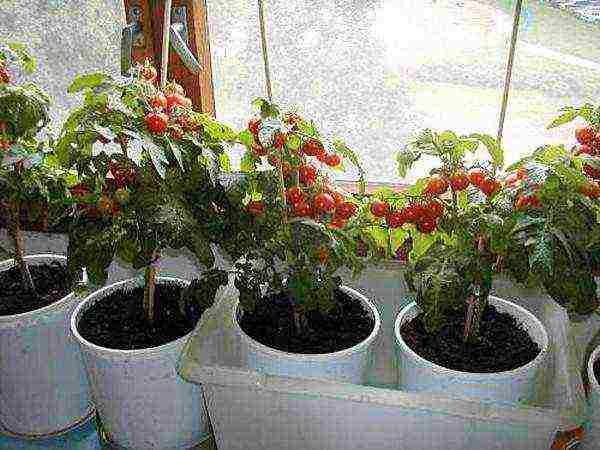
Medium-sized varieties can be tied to a peg. When planting tomatoes in a large pot, a peg, 50-60 cm long (from ground level), is also dug in along with the plant. When the plant reaches the desired size, it can be easily tied to this peg.
If you do not prepare in advance and dig in a peg, then later, when the plant is already large, they can damage the roots.
You can tie it up with an old nylon stocking, or with a strip of flannel cloth. Only this must be done carefully, the node should not be placed on the plant.
Pollination
Tomatoes do not require artificial pollination, but for better tying, you can lightly tap the stem several times a week, shaking the flower brushes. After the main part of the fruit is formed, the top of the plant, like the flowering brushes, should be removed, since they will not allow the already formed fruits to fully develop.
With poor ventilation, high ambient temperatures, insufficient soil moisture and poor illumination, plant leaves do not curl, but stretch upward, flowers and fruits fall off. It is necessary to often ventilate the room and water the plants, carefully monitor the temperature regime. With excessive watering and feeding, on the contrary, a powerful dark green bush with weak flower brushes is formed. In this case, the plant is less often fed, the soil is not watered for about a week, and the flowers are manually pollinated with cotton swabs.
Lemons grown in an apartment look very nice (and tasty).
The main recommendations for the successful cultivation of tomatoes on a windowsill or balcony
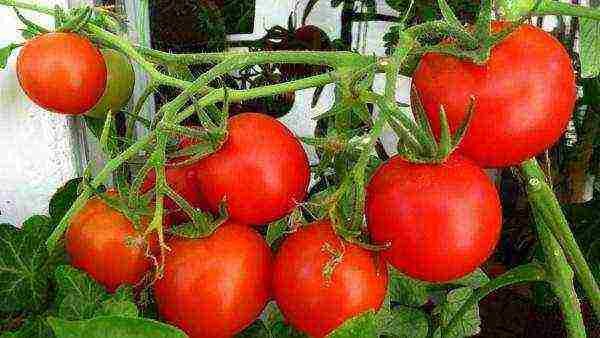
— It is better to give preference to small-fruited, but high-yielding hybrids and varieties of tomatoes. In a small area, it is difficult for a plant to feed large fruits, they will be few or they will ripen for a long time. Small fruits ripen gradually, which will provide fresh vegetables every day.
— Choosing the right seed is important... For growing in a city apartment, self-pollinating early maturing undersized or bush hybrids will be most suitable. Nowadays, special varieties have also been bred for home cultivation (in this case, “suitable for growing in an apartment” will be indicated on the seed bags).
- So that a beautiful, juicy, fruiting bush grows from a seed, the plant needs to provide a suitable temperature and the required amount of light. Vegetable beds should be located on the south or southeast windows. On short winter days, supplementary lighting with fluorescent lamps is mandatory.
— Do not allow the soil to dry out. In the heat, the plant can shed flowers and ovary. If there is no time to monitor soil moisture, you can arrange an "irrigation system". To do this, you need to dig a plastic bottle into the ground, having previously made several holes in it. Which side to dig it in depends on the size of the pot. The main thing is that there is a funnel on the surface for pouring water. Thus, the roots will constantly receive moisture, and the ground will not be covered with a crust on top.
- feed the plants once a month is enough. During flowering, the twigs need to be wiggled a little to improve pollination. For these purposes, you can use a universal fertilizer for indoor flowers or specialized growth concentrates. But it is very important not to overuse fertilizers, the saying "you cannot spoil porridge with oil" is inappropriate here. The rate specified in the fertilizer instructions cannot be exceeded. Better yet, divide it in half (it is better to feed it more often). In order not to burn the roots, the plant must first be watered with clean water, and only then with a fertilizer solution.
- Pots with seedlings and mature shrubs must be turned 180 degrees once a day... This is necessary so that the bushes are even, as plants tend to bend towards the light. And, at the same time, it is necessary to protect the plants from the scorching rays of the sun. Burns on the leaves and the yield can be significantly reduced, and the appearance of the plant will spoil. To do this, you can "tint" the glass with white paper - and the room will not be so hot, and the plants will become more comfortable.
- Do not pluck the tomatoes unripe. Spreading on a bush, they become fragrant and juicy. This is what we lack in purchased fruits.
- Do not force the plants to compete. Having planted two bushes in one pot, you can not only not increase the harvest, but lose it altogether. If there is nowhere to transplant the extra plants, it is better to throw them away altogether, and then the rest will please with a generous harvest.
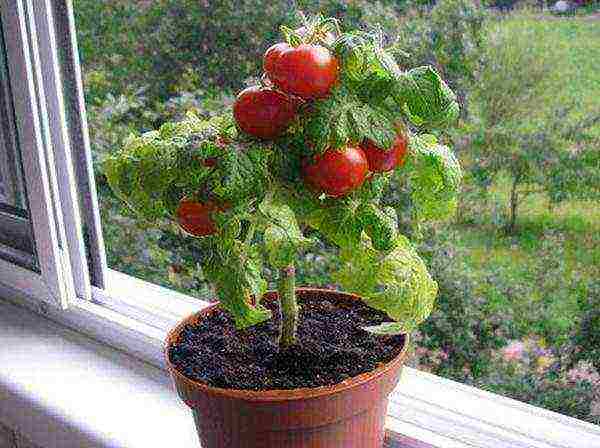
P.S. It is no secret that many insects, including mosquitoes and ants, cannot stand the specific smell of tomato tops. Several pots of plants tomatoes on the windowsill will become a reliable barrier against mosquitoes in the hot season.

